LAW1031/2409: Negotiation and Dispute Resolution Assignment, RMIT
VerifiedAdded on 2022/08/13
|15
|3593
|23
Report
AI Summary
This assignment is a report analyzing negotiation and dispute resolution, addressing both scenario-based problems and a research essay. Part One presents a case study involving a construction dispute between twin sisters and a construction company, Prestige Ltd, focusing on their BATNAs and WATNAs, strategies employed, and relevant legal issues such as confidentiality and admissibility. The scenario highlights mediator bias and ethical concerns. Part Two is a research essay comparing evaluative and transformative mediation, arguing for the efficiency of evaluative mediation in court-connected contexts. It discusses the advantages and disadvantages of each approach, considering the Australian construction industry context and the increasing preference for evaluative mediation, despite criticisms regarding mediator bias and the potential for clients to be misinformed. The report draws on legal concepts, ethical considerations, and real-world examples to explore effective dispute resolution methods.
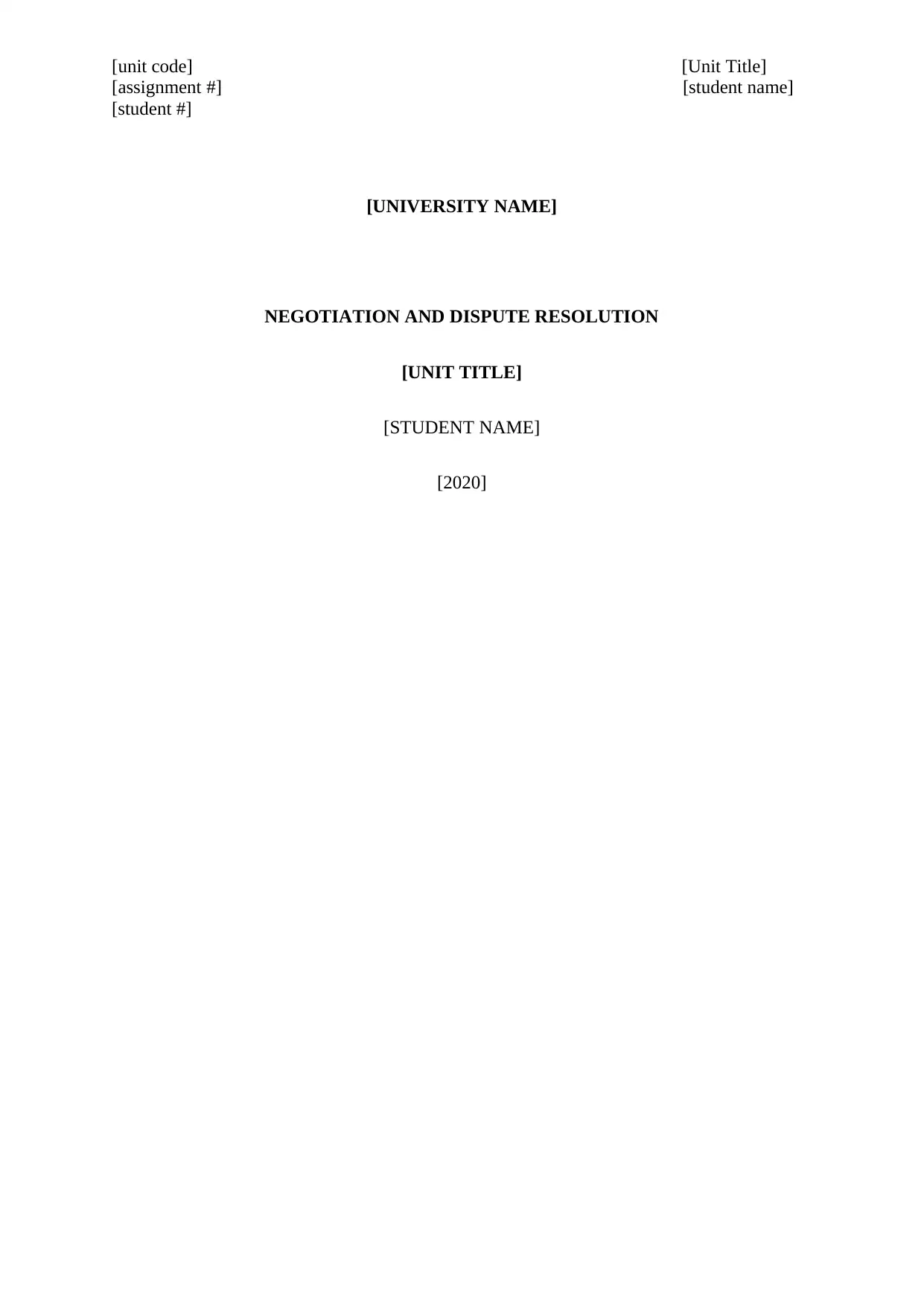
[unit code] [Unit Title]
[assignment #] [student name]
[student #]
[UNIVERSITY NAME]
NEGOTIATION AND DISPUTE RESOLUTION
[UNIT TITLE]
[STUDENT NAME]
[2020]
[assignment #] [student name]
[student #]
[UNIVERSITY NAME]
NEGOTIATION AND DISPUTE RESOLUTION
[UNIT TITLE]
[STUDENT NAME]
[2020]
Paraphrase This Document
Need a fresh take? Get an instant paraphrase of this document with our AI Paraphraser
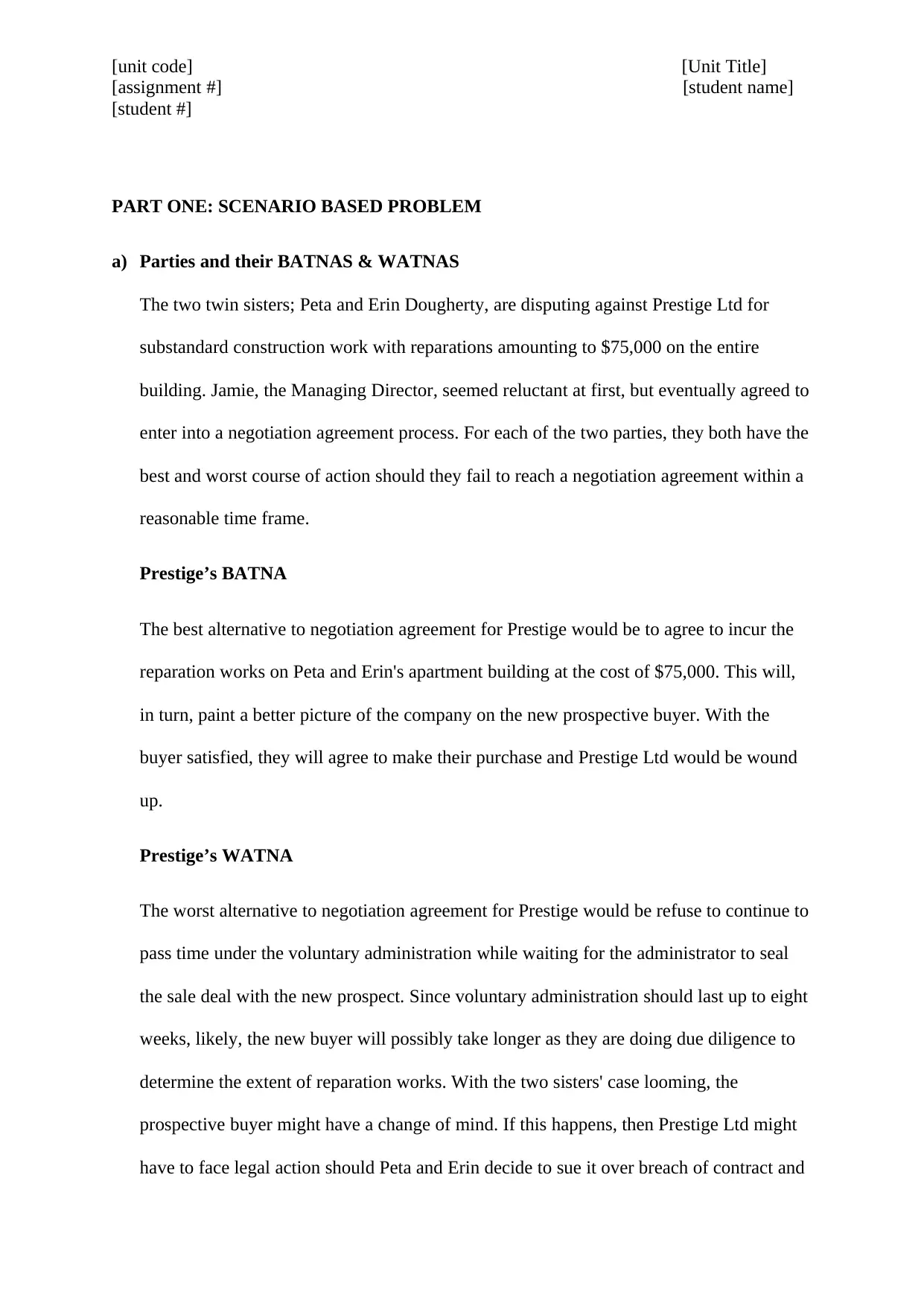
[unit code] [Unit Title]
[assignment #] [student name]
[student #]
PART ONE: SCENARIO BASED PROBLEM
a) Parties and their BATNAS & WATNAS
The two twin sisters; Peta and Erin Dougherty, are disputing against Prestige Ltd for
substandard construction work with reparations amounting to $75,000 on the entire
building. Jamie, the Managing Director, seemed reluctant at first, but eventually agreed to
enter into a negotiation agreement process. For each of the two parties, they both have the
best and worst course of action should they fail to reach a negotiation agreement within a
reasonable time frame.
Prestige’s BATNA
The best alternative to negotiation agreement for Prestige would be to agree to incur the
reparation works on Peta and Erin's apartment building at the cost of $75,000. This will,
in turn, paint a better picture of the company on the new prospective buyer. With the
buyer satisfied, they will agree to make their purchase and Prestige Ltd would be wound
up.
Prestige’s WATNA
The worst alternative to negotiation agreement for Prestige would be refuse to continue to
pass time under the voluntary administration while waiting for the administrator to seal
the sale deal with the new prospect. Since voluntary administration should last up to eight
weeks, likely, the new buyer will possibly take longer as they are doing due diligence to
determine the extent of reparation works. With the two sisters' case looming, the
prospective buyer might have a change of mind. If this happens, then Prestige Ltd might
have to face legal action should Peta and Erin decide to sue it over breach of contract and
[assignment #] [student name]
[student #]
PART ONE: SCENARIO BASED PROBLEM
a) Parties and their BATNAS & WATNAS
The two twin sisters; Peta and Erin Dougherty, are disputing against Prestige Ltd for
substandard construction work with reparations amounting to $75,000 on the entire
building. Jamie, the Managing Director, seemed reluctant at first, but eventually agreed to
enter into a negotiation agreement process. For each of the two parties, they both have the
best and worst course of action should they fail to reach a negotiation agreement within a
reasonable time frame.
Prestige’s BATNA
The best alternative to negotiation agreement for Prestige would be to agree to incur the
reparation works on Peta and Erin's apartment building at the cost of $75,000. This will,
in turn, paint a better picture of the company on the new prospective buyer. With the
buyer satisfied, they will agree to make their purchase and Prestige Ltd would be wound
up.
Prestige’s WATNA
The worst alternative to negotiation agreement for Prestige would be refuse to continue to
pass time under the voluntary administration while waiting for the administrator to seal
the sale deal with the new prospect. Since voluntary administration should last up to eight
weeks, likely, the new buyer will possibly take longer as they are doing due diligence to
determine the extent of reparation works. With the two sisters' case looming, the
prospective buyer might have a change of mind. If this happens, then Prestige Ltd might
have to face legal action should Peta and Erin decide to sue it over breach of contract and
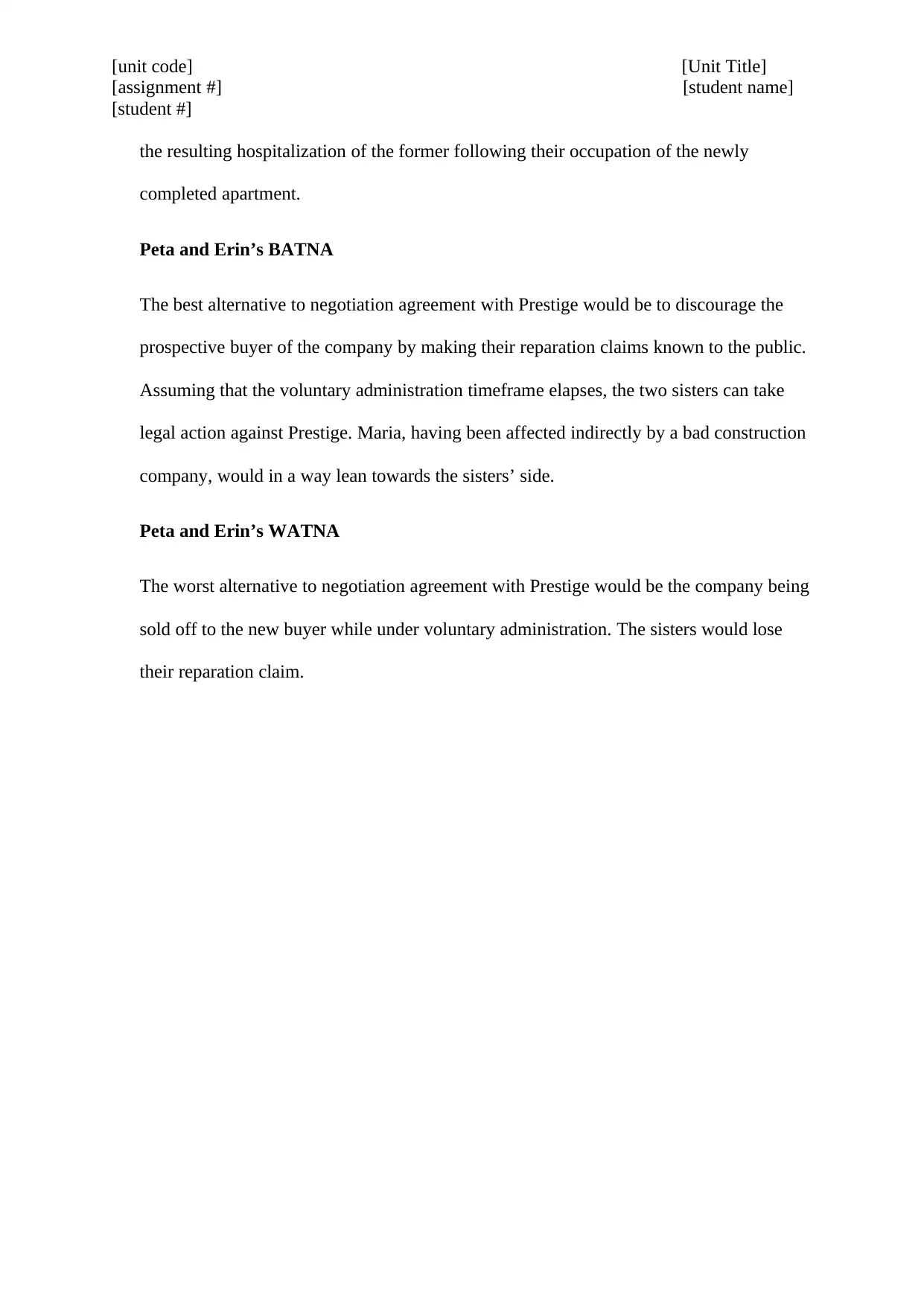
[unit code] [Unit Title]
[assignment #] [student name]
[student #]
the resulting hospitalization of the former following their occupation of the newly
completed apartment.
Peta and Erin’s BATNA
The best alternative to negotiation agreement with Prestige would be to discourage the
prospective buyer of the company by making their reparation claims known to the public.
Assuming that the voluntary administration timeframe elapses, the two sisters can take
legal action against Prestige. Maria, having been affected indirectly by a bad construction
company, would in a way lean towards the sisters’ side.
Peta and Erin’s WATNA
The worst alternative to negotiation agreement with Prestige would be the company being
sold off to the new buyer while under voluntary administration. The sisters would lose
their reparation claim.
[assignment #] [student name]
[student #]
the resulting hospitalization of the former following their occupation of the newly
completed apartment.
Peta and Erin’s BATNA
The best alternative to negotiation agreement with Prestige would be to discourage the
prospective buyer of the company by making their reparation claims known to the public.
Assuming that the voluntary administration timeframe elapses, the two sisters can take
legal action against Prestige. Maria, having been affected indirectly by a bad construction
company, would in a way lean towards the sisters’ side.
Peta and Erin’s WATNA
The worst alternative to negotiation agreement with Prestige would be the company being
sold off to the new buyer while under voluntary administration. The sisters would lose
their reparation claim.
⊘ This is a preview!⊘
Do you want full access?
Subscribe today to unlock all pages.

Trusted by 1+ million students worldwide
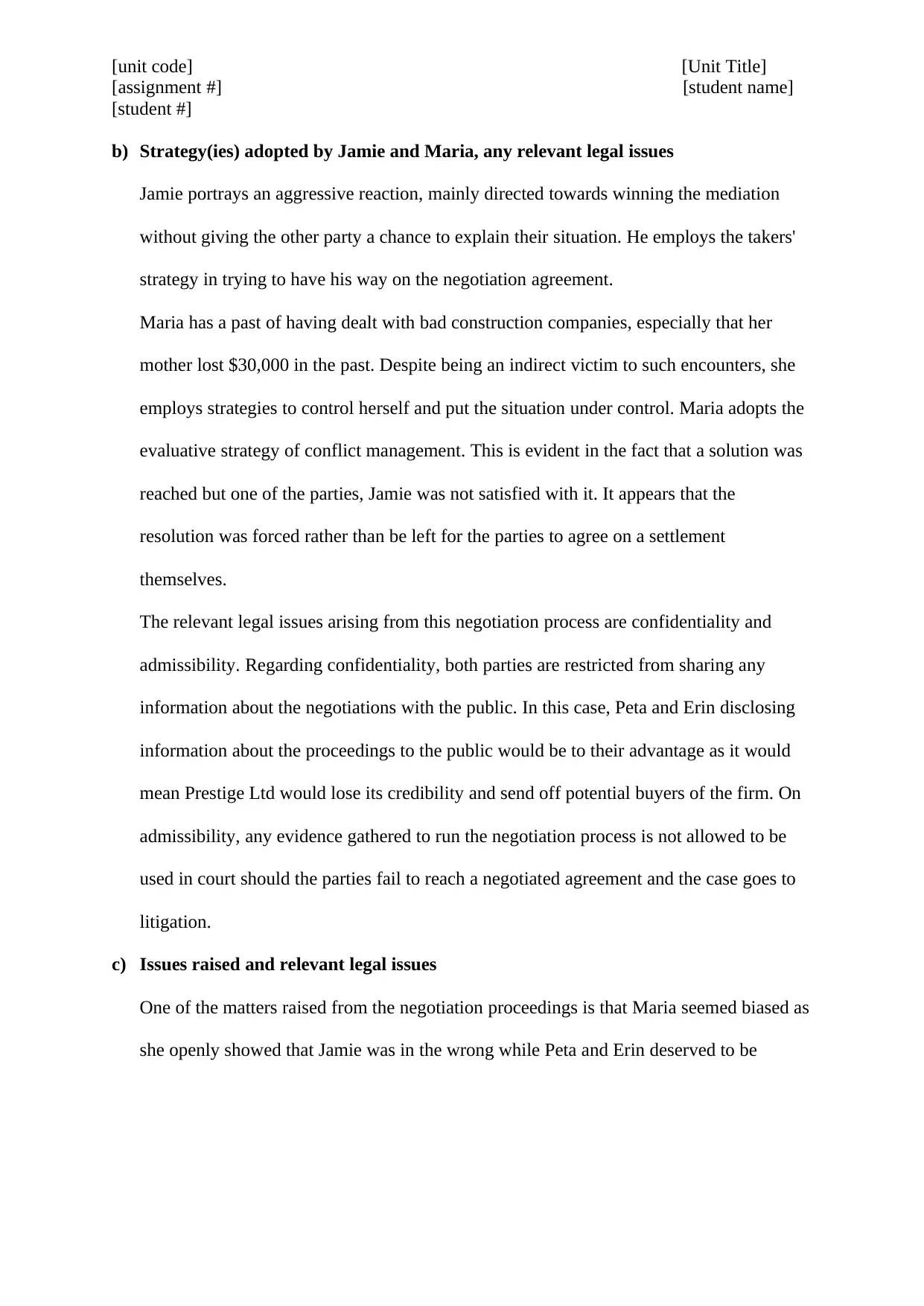
[unit code] [Unit Title]
[assignment #] [student name]
[student #]
b) Strategy(ies) adopted by Jamie and Maria, any relevant legal issues
Jamie portrays an aggressive reaction, mainly directed towards winning the mediation
without giving the other party a chance to explain their situation. He employs the takers'
strategy in trying to have his way on the negotiation agreement.
Maria has a past of having dealt with bad construction companies, especially that her
mother lost $30,000 in the past. Despite being an indirect victim to such encounters, she
employs strategies to control herself and put the situation under control. Maria adopts the
evaluative strategy of conflict management. This is evident in the fact that a solution was
reached but one of the parties, Jamie was not satisfied with it. It appears that the
resolution was forced rather than be left for the parties to agree on a settlement
themselves.
The relevant legal issues arising from this negotiation process are confidentiality and
admissibility. Regarding confidentiality, both parties are restricted from sharing any
information about the negotiations with the public. In this case, Peta and Erin disclosing
information about the proceedings to the public would be to their advantage as it would
mean Prestige Ltd would lose its credibility and send off potential buyers of the firm. On
admissibility, any evidence gathered to run the negotiation process is not allowed to be
used in court should the parties fail to reach a negotiated agreement and the case goes to
litigation.
c) Issues raised and relevant legal issues
One of the matters raised from the negotiation proceedings is that Maria seemed biased as
she openly showed that Jamie was in the wrong while Peta and Erin deserved to be
[assignment #] [student name]
[student #]
b) Strategy(ies) adopted by Jamie and Maria, any relevant legal issues
Jamie portrays an aggressive reaction, mainly directed towards winning the mediation
without giving the other party a chance to explain their situation. He employs the takers'
strategy in trying to have his way on the negotiation agreement.
Maria has a past of having dealt with bad construction companies, especially that her
mother lost $30,000 in the past. Despite being an indirect victim to such encounters, she
employs strategies to control herself and put the situation under control. Maria adopts the
evaluative strategy of conflict management. This is evident in the fact that a solution was
reached but one of the parties, Jamie was not satisfied with it. It appears that the
resolution was forced rather than be left for the parties to agree on a settlement
themselves.
The relevant legal issues arising from this negotiation process are confidentiality and
admissibility. Regarding confidentiality, both parties are restricted from sharing any
information about the negotiations with the public. In this case, Peta and Erin disclosing
information about the proceedings to the public would be to their advantage as it would
mean Prestige Ltd would lose its credibility and send off potential buyers of the firm. On
admissibility, any evidence gathered to run the negotiation process is not allowed to be
used in court should the parties fail to reach a negotiated agreement and the case goes to
litigation.
c) Issues raised and relevant legal issues
One of the matters raised from the negotiation proceedings is that Maria seemed biased as
she openly showed that Jamie was in the wrong while Peta and Erin deserved to be
Paraphrase This Document
Need a fresh take? Get an instant paraphrase of this document with our AI Paraphraser
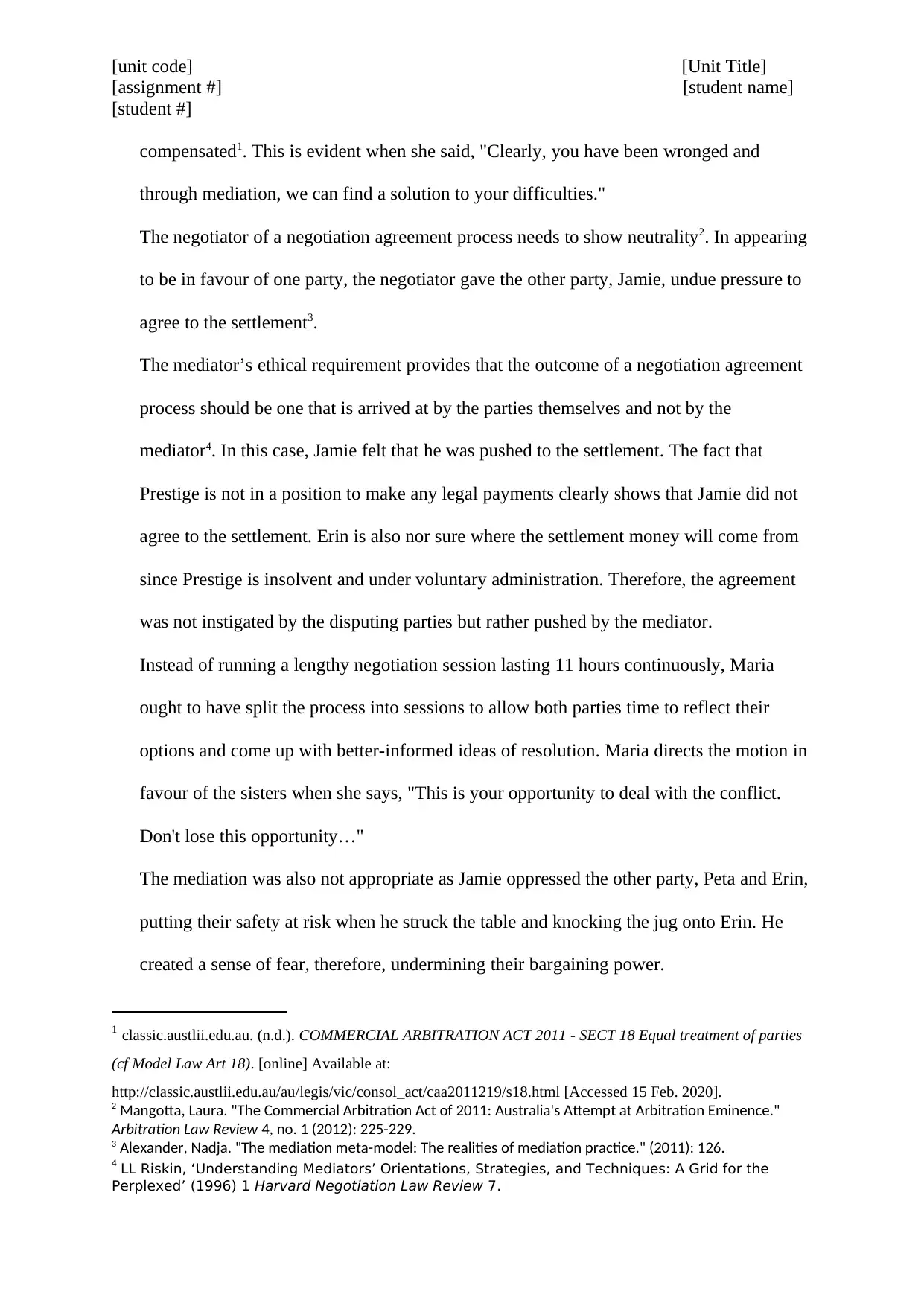
[unit code] [Unit Title]
[assignment #] [student name]
[student #]
compensated1. This is evident when she said, "Clearly, you have been wronged and
through mediation, we can find a solution to your difficulties."
The negotiator of a negotiation agreement process needs to show neutrality2. In appearing
to be in favour of one party, the negotiator gave the other party, Jamie, undue pressure to
agree to the settlement3.
The mediator’s ethical requirement provides that the outcome of a negotiation agreement
process should be one that is arrived at by the parties themselves and not by the
mediator4. In this case, Jamie felt that he was pushed to the settlement. The fact that
Prestige is not in a position to make any legal payments clearly shows that Jamie did not
agree to the settlement. Erin is also nor sure where the settlement money will come from
since Prestige is insolvent and under voluntary administration. Therefore, the agreement
was not instigated by the disputing parties but rather pushed by the mediator.
Instead of running a lengthy negotiation session lasting 11 hours continuously, Maria
ought to have split the process into sessions to allow both parties time to reflect their
options and come up with better-informed ideas of resolution. Maria directs the motion in
favour of the sisters when she says, "This is your opportunity to deal with the conflict.
Don't lose this opportunity…"
The mediation was also not appropriate as Jamie oppressed the other party, Peta and Erin,
putting their safety at risk when he struck the table and knocking the jug onto Erin. He
created a sense of fear, therefore, undermining their bargaining power.
1 classic.austlii.edu.au. (n.d.). COMMERCIAL ARBITRATION ACT 2011 - SECT 18 Equal treatment of parties
(cf Model Law Art 18). [online] Available at:
http://classic.austlii.edu.au/au/legis/vic/consol_act/caa2011219/s18.html [Accessed 15 Feb. 2020].
2 Mangotta, Laura. "The Commercial Arbitration Act of 2011: Australia's Attempt at Arbitration Eminence."
Arbitration Law Review 4, no. 1 (2012): 225-229.
3 Alexander, Nadja. "The mediation meta-model: The realities of mediation practice." (2011): 126.
4 LL Riskin, ‘Understanding Mediators’ Orientations, Strategies, and Techniques: A Grid for the
Perplexed’ (1996) 1 Harvard Negotiation Law Review 7.
[assignment #] [student name]
[student #]
compensated1. This is evident when she said, "Clearly, you have been wronged and
through mediation, we can find a solution to your difficulties."
The negotiator of a negotiation agreement process needs to show neutrality2. In appearing
to be in favour of one party, the negotiator gave the other party, Jamie, undue pressure to
agree to the settlement3.
The mediator’s ethical requirement provides that the outcome of a negotiation agreement
process should be one that is arrived at by the parties themselves and not by the
mediator4. In this case, Jamie felt that he was pushed to the settlement. The fact that
Prestige is not in a position to make any legal payments clearly shows that Jamie did not
agree to the settlement. Erin is also nor sure where the settlement money will come from
since Prestige is insolvent and under voluntary administration. Therefore, the agreement
was not instigated by the disputing parties but rather pushed by the mediator.
Instead of running a lengthy negotiation session lasting 11 hours continuously, Maria
ought to have split the process into sessions to allow both parties time to reflect their
options and come up with better-informed ideas of resolution. Maria directs the motion in
favour of the sisters when she says, "This is your opportunity to deal with the conflict.
Don't lose this opportunity…"
The mediation was also not appropriate as Jamie oppressed the other party, Peta and Erin,
putting their safety at risk when he struck the table and knocking the jug onto Erin. He
created a sense of fear, therefore, undermining their bargaining power.
1 classic.austlii.edu.au. (n.d.). COMMERCIAL ARBITRATION ACT 2011 - SECT 18 Equal treatment of parties
(cf Model Law Art 18). [online] Available at:
http://classic.austlii.edu.au/au/legis/vic/consol_act/caa2011219/s18.html [Accessed 15 Feb. 2020].
2 Mangotta, Laura. "The Commercial Arbitration Act of 2011: Australia's Attempt at Arbitration Eminence."
Arbitration Law Review 4, no. 1 (2012): 225-229.
3 Alexander, Nadja. "The mediation meta-model: The realities of mediation practice." (2011): 126.
4 LL Riskin, ‘Understanding Mediators’ Orientations, Strategies, and Techniques: A Grid for the
Perplexed’ (1996) 1 Harvard Negotiation Law Review 7.
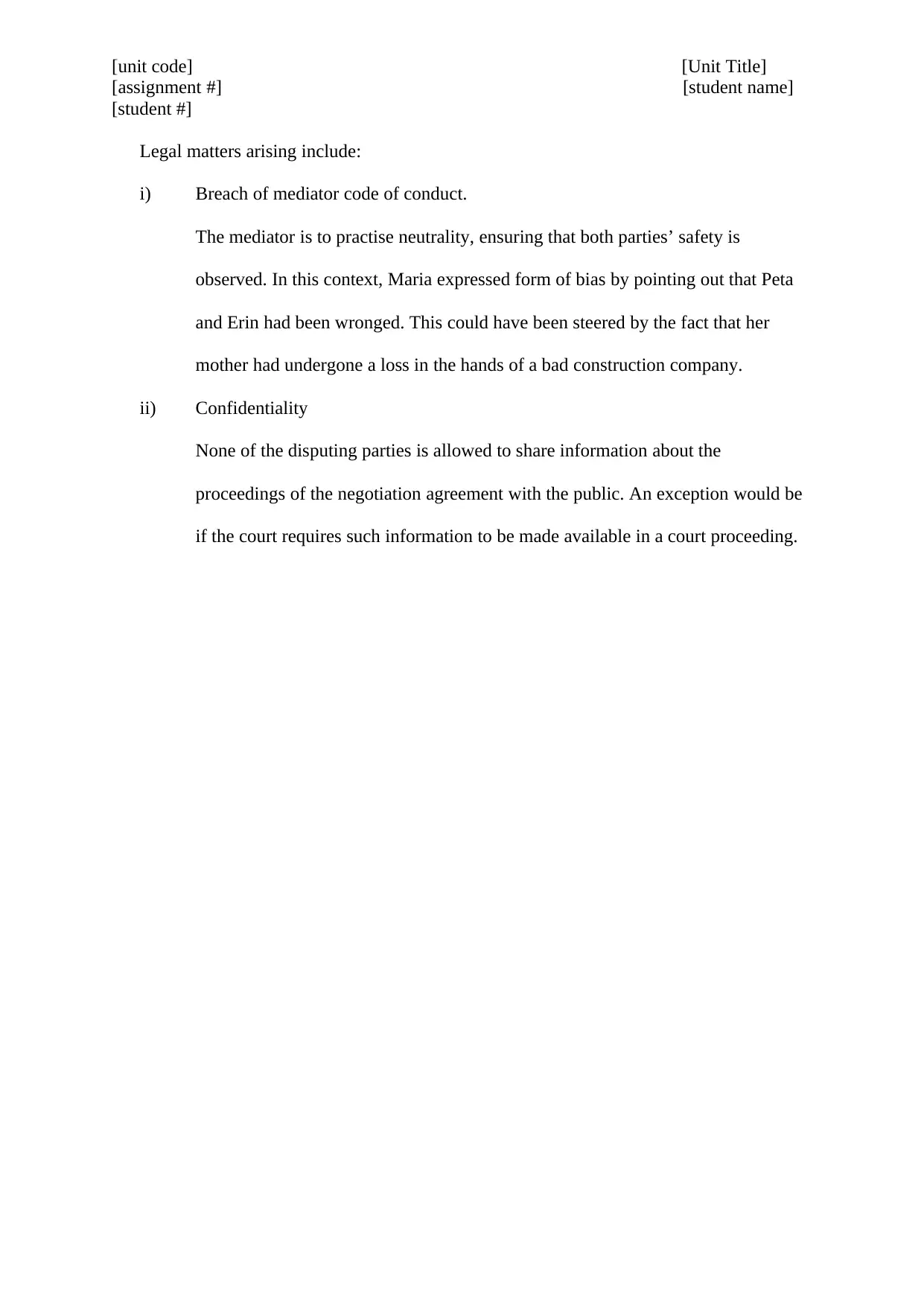
[unit code] [Unit Title]
[assignment #] [student name]
[student #]
Legal matters arising include:
i) Breach of mediator code of conduct.
The mediator is to practise neutrality, ensuring that both parties’ safety is
observed. In this context, Maria expressed form of bias by pointing out that Peta
and Erin had been wronged. This could have been steered by the fact that her
mother had undergone a loss in the hands of a bad construction company.
ii) Confidentiality
None of the disputing parties is allowed to share information about the
proceedings of the negotiation agreement with the public. An exception would be
if the court requires such information to be made available in a court proceeding.
[assignment #] [student name]
[student #]
Legal matters arising include:
i) Breach of mediator code of conduct.
The mediator is to practise neutrality, ensuring that both parties’ safety is
observed. In this context, Maria expressed form of bias by pointing out that Peta
and Erin had been wronged. This could have been steered by the fact that her
mother had undergone a loss in the hands of a bad construction company.
ii) Confidentiality
None of the disputing parties is allowed to share information about the
proceedings of the negotiation agreement with the public. An exception would be
if the court requires such information to be made available in a court proceeding.
⊘ This is a preview!⊘
Do you want full access?
Subscribe today to unlock all pages.

Trusted by 1+ million students worldwide
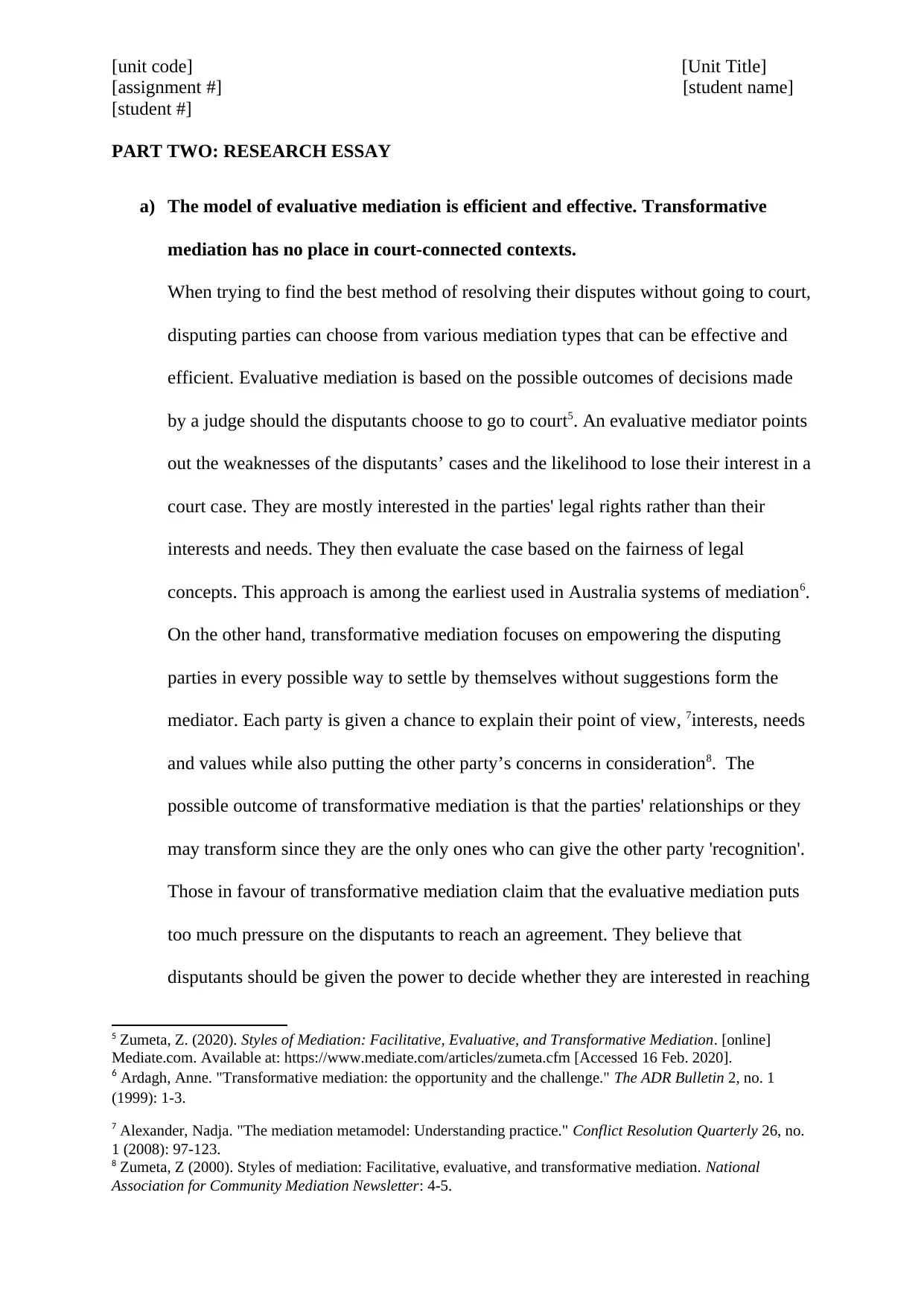
[unit code] [Unit Title]
[assignment #] [student name]
[student #]
PART TWO: RESEARCH ESSAY
a) The model of evaluative mediation is efficient and effective. Transformative
mediation has no place in court-connected contexts.
When trying to find the best method of resolving their disputes without going to court,
disputing parties can choose from various mediation types that can be effective and
efficient. Evaluative mediation is based on the possible outcomes of decisions made
by a judge should the disputants choose to go to court5. An evaluative mediator points
out the weaknesses of the disputants’ cases and the likelihood to lose their interest in a
court case. They are mostly interested in the parties' legal rights rather than their
interests and needs. They then evaluate the case based on the fairness of legal
concepts. This approach is among the earliest used in Australia systems of mediation6.
On the other hand, transformative mediation focuses on empowering the disputing
parties in every possible way to settle by themselves without suggestions form the
mediator. Each party is given a chance to explain their point of view, 7interests, needs
and values while also putting the other party’s concerns in consideration8. The
possible outcome of transformative mediation is that the parties' relationships or they
may transform since they are the only ones who can give the other party 'recognition'.
Those in favour of transformative mediation claim that the evaluative mediation puts
too much pressure on the disputants to reach an agreement. They believe that
disputants should be given the power to decide whether they are interested in reaching
5 Zumeta, Z. (2020). Styles of Mediation: Facilitative, Evaluative, and Transformative Mediation. [online]
Mediate.com. Available at: https://www.mediate.com/articles/zumeta.cfm [Accessed 16 Feb. 2020].
6 Ardagh, Anne. "Transformative mediation: the opportunity and the challenge." The ADR Bulletin 2, no. 1
(1999): 1-3.
7 Alexander, Nadja. "The mediation metamodel: Understanding practice." Conflict Resolution Quarterly 26, no.
1 (2008): 97-123.
8 Zumeta, Z (2000). Styles of mediation: Facilitative, evaluative, and transformative mediation. National
Association for Community Mediation Newsletter: 4-5.
[assignment #] [student name]
[student #]
PART TWO: RESEARCH ESSAY
a) The model of evaluative mediation is efficient and effective. Transformative
mediation has no place in court-connected contexts.
When trying to find the best method of resolving their disputes without going to court,
disputing parties can choose from various mediation types that can be effective and
efficient. Evaluative mediation is based on the possible outcomes of decisions made
by a judge should the disputants choose to go to court5. An evaluative mediator points
out the weaknesses of the disputants’ cases and the likelihood to lose their interest in a
court case. They are mostly interested in the parties' legal rights rather than their
interests and needs. They then evaluate the case based on the fairness of legal
concepts. This approach is among the earliest used in Australia systems of mediation6.
On the other hand, transformative mediation focuses on empowering the disputing
parties in every possible way to settle by themselves without suggestions form the
mediator. Each party is given a chance to explain their point of view, 7interests, needs
and values while also putting the other party’s concerns in consideration8. The
possible outcome of transformative mediation is that the parties' relationships or they
may transform since they are the only ones who can give the other party 'recognition'.
Those in favour of transformative mediation claim that the evaluative mediation puts
too much pressure on the disputants to reach an agreement. They believe that
disputants should be given the power to decide whether they are interested in reaching
5 Zumeta, Z. (2020). Styles of Mediation: Facilitative, Evaluative, and Transformative Mediation. [online]
Mediate.com. Available at: https://www.mediate.com/articles/zumeta.cfm [Accessed 16 Feb. 2020].
6 Ardagh, Anne. "Transformative mediation: the opportunity and the challenge." The ADR Bulletin 2, no. 1
(1999): 1-3.
7 Alexander, Nadja. "The mediation metamodel: Understanding practice." Conflict Resolution Quarterly 26, no.
1 (2008): 97-123.
8 Zumeta, Z (2000). Styles of mediation: Facilitative, evaluative, and transformative mediation. National
Association for Community Mediation Newsletter: 4-5.
Paraphrase This Document
Need a fresh take? Get an instant paraphrase of this document with our AI Paraphraser
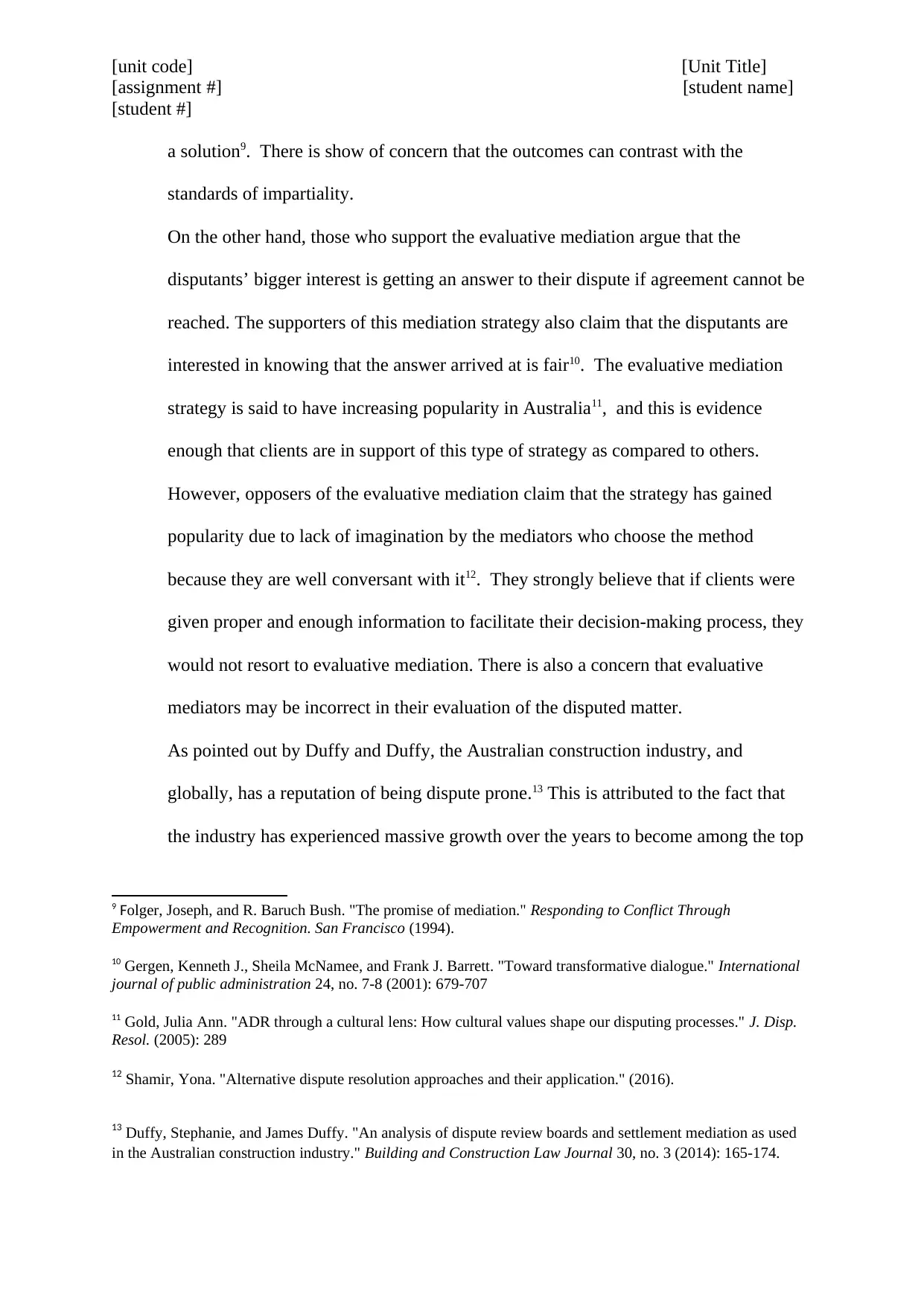
[unit code] [Unit Title]
[assignment #] [student name]
[student #]
a solution9. There is show of concern that the outcomes can contrast with the
standards of impartiality.
On the other hand, those who support the evaluative mediation argue that the
disputants’ bigger interest is getting an answer to their dispute if agreement cannot be
reached. The supporters of this mediation strategy also claim that the disputants are
interested in knowing that the answer arrived at is fair10. The evaluative mediation
strategy is said to have increasing popularity in Australia11, and this is evidence
enough that clients are in support of this type of strategy as compared to others.
However, opposers of the evaluative mediation claim that the strategy has gained
popularity due to lack of imagination by the mediators who choose the method
because they are well conversant with it12. They strongly believe that if clients were
given proper and enough information to facilitate their decision-making process, they
would not resort to evaluative mediation. There is also a concern that evaluative
mediators may be incorrect in their evaluation of the disputed matter.
As pointed out by Duffy and Duffy, the Australian construction industry, and
globally, has a reputation of being dispute prone.13 This is attributed to the fact that
the industry has experienced massive growth over the years to become among the top
9 Folger, Joseph, and R. Baruch Bush. "The promise of mediation." Responding to Conflict Through
Empowerment and Recognition. San Francisco (1994).
10 Gergen, Kenneth J., Sheila McNamee, and Frank J. Barrett. "Toward transformative dialogue." International
journal of public administration 24, no. 7-8 (2001): 679-707
11 Gold, Julia Ann. "ADR through a cultural lens: How cultural values shape our disputing processes." J. Disp.
Resol. (2005): 289
12 Shamir, Yona. "Alternative dispute resolution approaches and their application." (2016).
13 Duffy, Stephanie, and James Duffy. "An analysis of dispute review boards and settlement mediation as used
in the Australian construction industry." Building and Construction Law Journal 30, no. 3 (2014): 165-174.
[assignment #] [student name]
[student #]
a solution9. There is show of concern that the outcomes can contrast with the
standards of impartiality.
On the other hand, those who support the evaluative mediation argue that the
disputants’ bigger interest is getting an answer to their dispute if agreement cannot be
reached. The supporters of this mediation strategy also claim that the disputants are
interested in knowing that the answer arrived at is fair10. The evaluative mediation
strategy is said to have increasing popularity in Australia11, and this is evidence
enough that clients are in support of this type of strategy as compared to others.
However, opposers of the evaluative mediation claim that the strategy has gained
popularity due to lack of imagination by the mediators who choose the method
because they are well conversant with it12. They strongly believe that if clients were
given proper and enough information to facilitate their decision-making process, they
would not resort to evaluative mediation. There is also a concern that evaluative
mediators may be incorrect in their evaluation of the disputed matter.
As pointed out by Duffy and Duffy, the Australian construction industry, and
globally, has a reputation of being dispute prone.13 This is attributed to the fact that
the industry has experienced massive growth over the years to become among the top
9 Folger, Joseph, and R. Baruch Bush. "The promise of mediation." Responding to Conflict Through
Empowerment and Recognition. San Francisco (1994).
10 Gergen, Kenneth J., Sheila McNamee, and Frank J. Barrett. "Toward transformative dialogue." International
journal of public administration 24, no. 7-8 (2001): 679-707
11 Gold, Julia Ann. "ADR through a cultural lens: How cultural values shape our disputing processes." J. Disp.
Resol. (2005): 289
12 Shamir, Yona. "Alternative dispute resolution approaches and their application." (2016).
13 Duffy, Stephanie, and James Duffy. "An analysis of dispute review boards and settlement mediation as used
in the Australian construction industry." Building and Construction Law Journal 30, no. 3 (2014): 165-174.
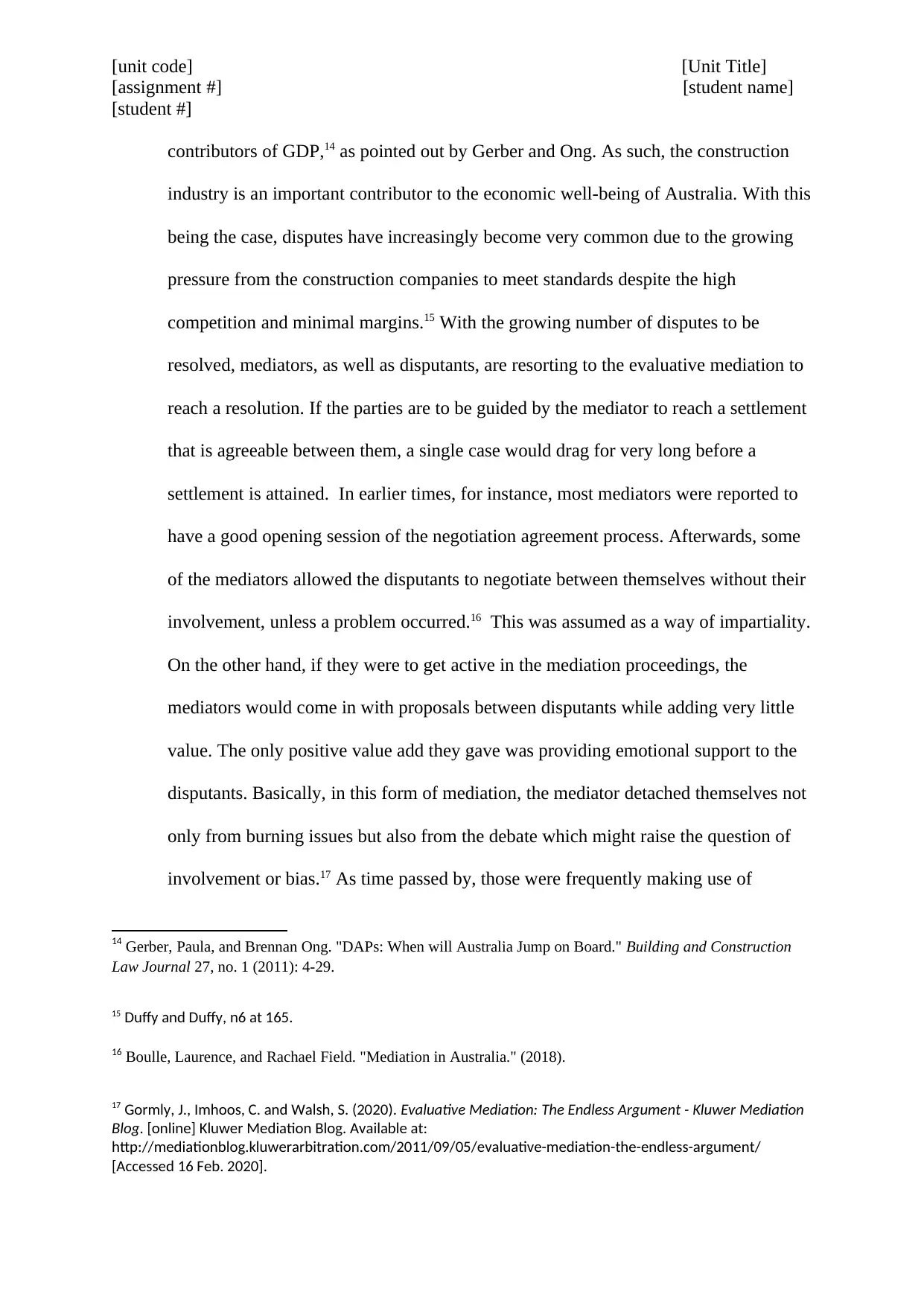
[unit code] [Unit Title]
[assignment #] [student name]
[student #]
contributors of GDP,14 as pointed out by Gerber and Ong. As such, the construction
industry is an important contributor to the economic well-being of Australia. With this
being the case, disputes have increasingly become very common due to the growing
pressure from the construction companies to meet standards despite the high
competition and minimal margins.15 With the growing number of disputes to be
resolved, mediators, as well as disputants, are resorting to the evaluative mediation to
reach a resolution. If the parties are to be guided by the mediator to reach a settlement
that is agreeable between them, a single case would drag for very long before a
settlement is attained. In earlier times, for instance, most mediators were reported to
have a good opening session of the negotiation agreement process. Afterwards, some
of the mediators allowed the disputants to negotiate between themselves without their
involvement, unless a problem occurred.16 This was assumed as a way of impartiality.
On the other hand, if they were to get active in the mediation proceedings, the
mediators would come in with proposals between disputants while adding very little
value. The only positive value add they gave was providing emotional support to the
disputants. Basically, in this form of mediation, the mediator detached themselves not
only from burning issues but also from the debate which might raise the question of
involvement or bias.17 As time passed by, those were frequently making use of
14 Gerber, Paula, and Brennan Ong. "DAPs: When will Australia Jump on Board." Building and Construction
Law Journal 27, no. 1 (2011): 4-29.
15 Duffy and Duffy, n6 at 165.
16 Boulle, Laurence, and Rachael Field. "Mediation in Australia." (2018).
17 Gormly, J., Imhoos, C. and Walsh, S. (2020). Evaluative Mediation: The Endless Argument - Kluwer Mediation
Blog. [online] Kluwer Mediation Blog. Available at:
http://mediationblog.kluwerarbitration.com/2011/09/05/evaluative-mediation-the-endless-argument/
[Accessed 16 Feb. 2020].
[assignment #] [student name]
[student #]
contributors of GDP,14 as pointed out by Gerber and Ong. As such, the construction
industry is an important contributor to the economic well-being of Australia. With this
being the case, disputes have increasingly become very common due to the growing
pressure from the construction companies to meet standards despite the high
competition and minimal margins.15 With the growing number of disputes to be
resolved, mediators, as well as disputants, are resorting to the evaluative mediation to
reach a resolution. If the parties are to be guided by the mediator to reach a settlement
that is agreeable between them, a single case would drag for very long before a
settlement is attained. In earlier times, for instance, most mediators were reported to
have a good opening session of the negotiation agreement process. Afterwards, some
of the mediators allowed the disputants to negotiate between themselves without their
involvement, unless a problem occurred.16 This was assumed as a way of impartiality.
On the other hand, if they were to get active in the mediation proceedings, the
mediators would come in with proposals between disputants while adding very little
value. The only positive value add they gave was providing emotional support to the
disputants. Basically, in this form of mediation, the mediator detached themselves not
only from burning issues but also from the debate which might raise the question of
involvement or bias.17 As time passed by, those were frequently making use of
14 Gerber, Paula, and Brennan Ong. "DAPs: When will Australia Jump on Board." Building and Construction
Law Journal 27, no. 1 (2011): 4-29.
15 Duffy and Duffy, n6 at 165.
16 Boulle, Laurence, and Rachael Field. "Mediation in Australia." (2018).
17 Gormly, J., Imhoos, C. and Walsh, S. (2020). Evaluative Mediation: The Endless Argument - Kluwer Mediation
Blog. [online] Kluwer Mediation Blog. Available at:
http://mediationblog.kluwerarbitration.com/2011/09/05/evaluative-mediation-the-endless-argument/
[Accessed 16 Feb. 2020].
⊘ This is a preview!⊘
Do you want full access?
Subscribe today to unlock all pages.

Trusted by 1+ million students worldwide
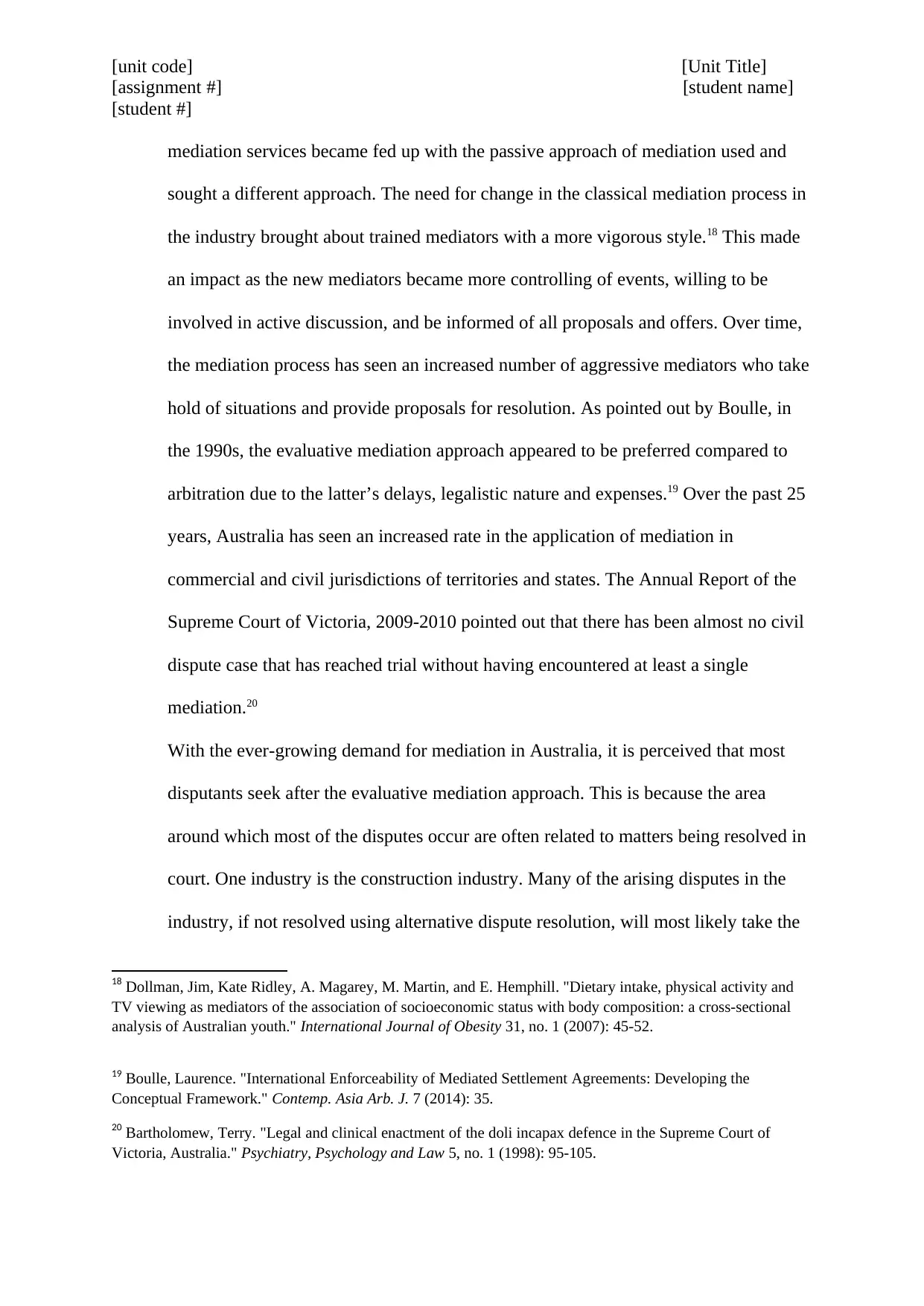
[unit code] [Unit Title]
[assignment #] [student name]
[student #]
mediation services became fed up with the passive approach of mediation used and
sought a different approach. The need for change in the classical mediation process in
the industry brought about trained mediators with a more vigorous style.18 This made
an impact as the new mediators became more controlling of events, willing to be
involved in active discussion, and be informed of all proposals and offers. Over time,
the mediation process has seen an increased number of aggressive mediators who take
hold of situations and provide proposals for resolution. As pointed out by Boulle, in
the 1990s, the evaluative mediation approach appeared to be preferred compared to
arbitration due to the latter’s delays, legalistic nature and expenses.19 Over the past 25
years, Australia has seen an increased rate in the application of mediation in
commercial and civil jurisdictions of territories and states. The Annual Report of the
Supreme Court of Victoria, 2009-2010 pointed out that there has been almost no civil
dispute case that has reached trial without having encountered at least a single
mediation.20
With the ever-growing demand for mediation in Australia, it is perceived that most
disputants seek after the evaluative mediation approach. This is because the area
around which most of the disputes occur are often related to matters being resolved in
court. One industry is the construction industry. Many of the arising disputes in the
industry, if not resolved using alternative dispute resolution, will most likely take the
18 Dollman, Jim, Kate Ridley, A. Magarey, M. Martin, and E. Hemphill. "Dietary intake, physical activity and
TV viewing as mediators of the association of socioeconomic status with body composition: a cross-sectional
analysis of Australian youth." International Journal of Obesity 31, no. 1 (2007): 45-52.
19 Boulle, Laurence. "International Enforceability of Mediated Settlement Agreements: Developing the
Conceptual Framework." Contemp. Asia Arb. J. 7 (2014): 35.
20 Bartholomew, Terry. "Legal and clinical enactment of the doli incapax defence in the Supreme Court of
Victoria, Australia." Psychiatry, Psychology and Law 5, no. 1 (1998): 95-105.
[assignment #] [student name]
[student #]
mediation services became fed up with the passive approach of mediation used and
sought a different approach. The need for change in the classical mediation process in
the industry brought about trained mediators with a more vigorous style.18 This made
an impact as the new mediators became more controlling of events, willing to be
involved in active discussion, and be informed of all proposals and offers. Over time,
the mediation process has seen an increased number of aggressive mediators who take
hold of situations and provide proposals for resolution. As pointed out by Boulle, in
the 1990s, the evaluative mediation approach appeared to be preferred compared to
arbitration due to the latter’s delays, legalistic nature and expenses.19 Over the past 25
years, Australia has seen an increased rate in the application of mediation in
commercial and civil jurisdictions of territories and states. The Annual Report of the
Supreme Court of Victoria, 2009-2010 pointed out that there has been almost no civil
dispute case that has reached trial without having encountered at least a single
mediation.20
With the ever-growing demand for mediation in Australia, it is perceived that most
disputants seek after the evaluative mediation approach. This is because the area
around which most of the disputes occur are often related to matters being resolved in
court. One industry is the construction industry. Many of the arising disputes in the
industry, if not resolved using alternative dispute resolution, will most likely take the
18 Dollman, Jim, Kate Ridley, A. Magarey, M. Martin, and E. Hemphill. "Dietary intake, physical activity and
TV viewing as mediators of the association of socioeconomic status with body composition: a cross-sectional
analysis of Australian youth." International Journal of Obesity 31, no. 1 (2007): 45-52.
19 Boulle, Laurence. "International Enforceability of Mediated Settlement Agreements: Developing the
Conceptual Framework." Contemp. Asia Arb. J. 7 (2014): 35.
20 Bartholomew, Terry. "Legal and clinical enactment of the doli incapax defence in the Supreme Court of
Victoria, Australia." Psychiatry, Psychology and Law 5, no. 1 (1998): 95-105.
Paraphrase This Document
Need a fresh take? Get an instant paraphrase of this document with our AI Paraphraser
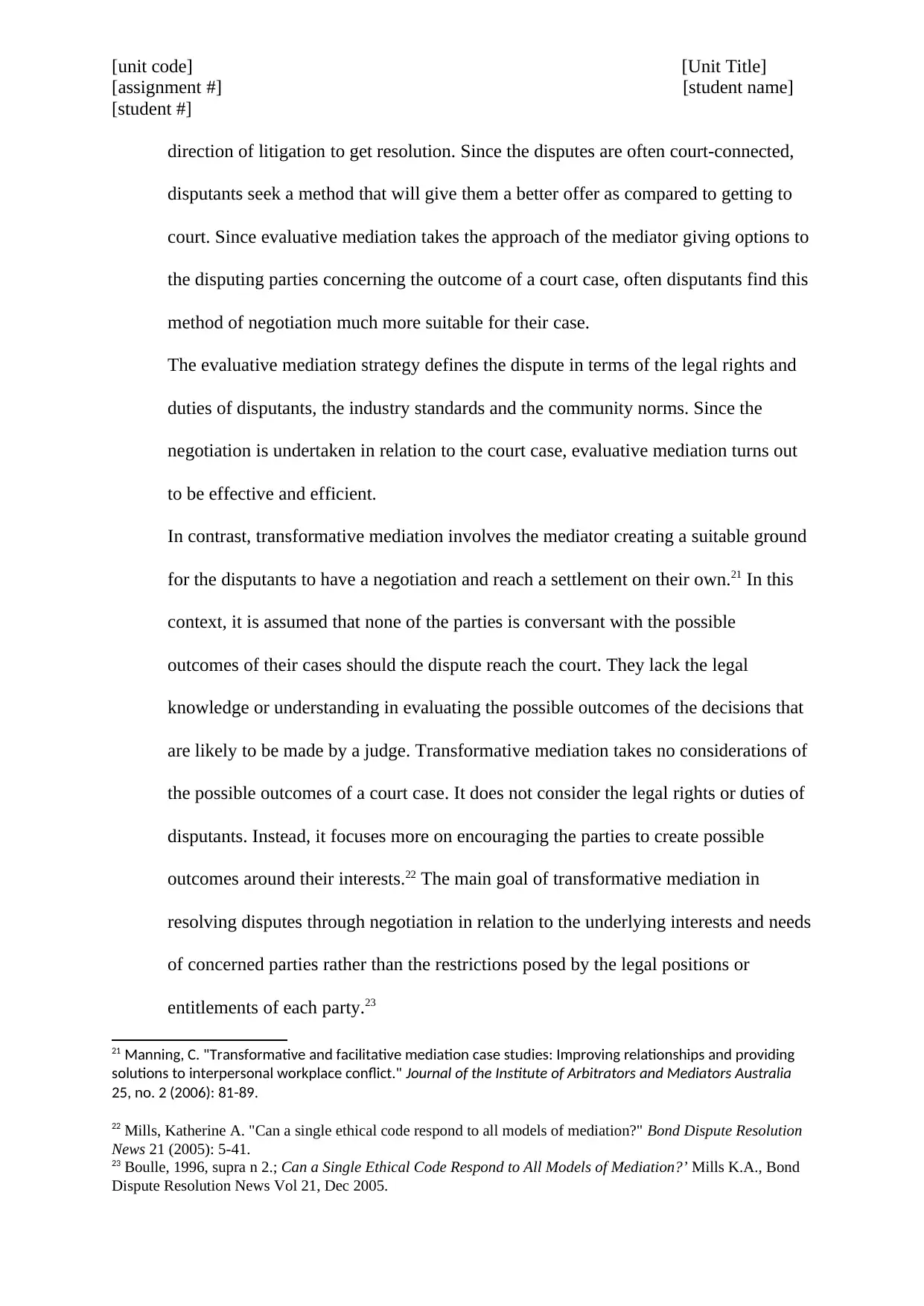
[unit code] [Unit Title]
[assignment #] [student name]
[student #]
direction of litigation to get resolution. Since the disputes are often court-connected,
disputants seek a method that will give them a better offer as compared to getting to
court. Since evaluative mediation takes the approach of the mediator giving options to
the disputing parties concerning the outcome of a court case, often disputants find this
method of negotiation much more suitable for their case.
The evaluative mediation strategy defines the dispute in terms of the legal rights and
duties of disputants, the industry standards and the community norms. Since the
negotiation is undertaken in relation to the court case, evaluative mediation turns out
to be effective and efficient.
In contrast, transformative mediation involves the mediator creating a suitable ground
for the disputants to have a negotiation and reach a settlement on their own.21 In this
context, it is assumed that none of the parties is conversant with the possible
outcomes of their cases should the dispute reach the court. They lack the legal
knowledge or understanding in evaluating the possible outcomes of the decisions that
are likely to be made by a judge. Transformative mediation takes no considerations of
the possible outcomes of a court case. It does not consider the legal rights or duties of
disputants. Instead, it focuses more on encouraging the parties to create possible
outcomes around their interests.22 The main goal of transformative mediation in
resolving disputes through negotiation in relation to the underlying interests and needs
of concerned parties rather than the restrictions posed by the legal positions or
entitlements of each party.23
21 Manning, C. "Transformative and facilitative mediation case studies: Improving relationships and providing
solutions to interpersonal workplace conflict." Journal of the Institute of Arbitrators and Mediators Australia
25, no. 2 (2006): 81-89.
22 Mills, Katherine A. "Can a single ethical code respond to all models of mediation?" Bond Dispute Resolution
News 21 (2005): 5-41.
23 Boulle, 1996, supra n 2.; Can a Single Ethical Code Respond to All Models of Mediation?’ Mills K.A., Bond
Dispute Resolution News Vol 21, Dec 2005.
[assignment #] [student name]
[student #]
direction of litigation to get resolution. Since the disputes are often court-connected,
disputants seek a method that will give them a better offer as compared to getting to
court. Since evaluative mediation takes the approach of the mediator giving options to
the disputing parties concerning the outcome of a court case, often disputants find this
method of negotiation much more suitable for their case.
The evaluative mediation strategy defines the dispute in terms of the legal rights and
duties of disputants, the industry standards and the community norms. Since the
negotiation is undertaken in relation to the court case, evaluative mediation turns out
to be effective and efficient.
In contrast, transformative mediation involves the mediator creating a suitable ground
for the disputants to have a negotiation and reach a settlement on their own.21 In this
context, it is assumed that none of the parties is conversant with the possible
outcomes of their cases should the dispute reach the court. They lack the legal
knowledge or understanding in evaluating the possible outcomes of the decisions that
are likely to be made by a judge. Transformative mediation takes no considerations of
the possible outcomes of a court case. It does not consider the legal rights or duties of
disputants. Instead, it focuses more on encouraging the parties to create possible
outcomes around their interests.22 The main goal of transformative mediation in
resolving disputes through negotiation in relation to the underlying interests and needs
of concerned parties rather than the restrictions posed by the legal positions or
entitlements of each party.23
21 Manning, C. "Transformative and facilitative mediation case studies: Improving relationships and providing
solutions to interpersonal workplace conflict." Journal of the Institute of Arbitrators and Mediators Australia
25, no. 2 (2006): 81-89.
22 Mills, Katherine A. "Can a single ethical code respond to all models of mediation?" Bond Dispute Resolution
News 21 (2005): 5-41.
23 Boulle, 1996, supra n 2.; Can a Single Ethical Code Respond to All Models of Mediation?’ Mills K.A., Bond
Dispute Resolution News Vol 21, Dec 2005.
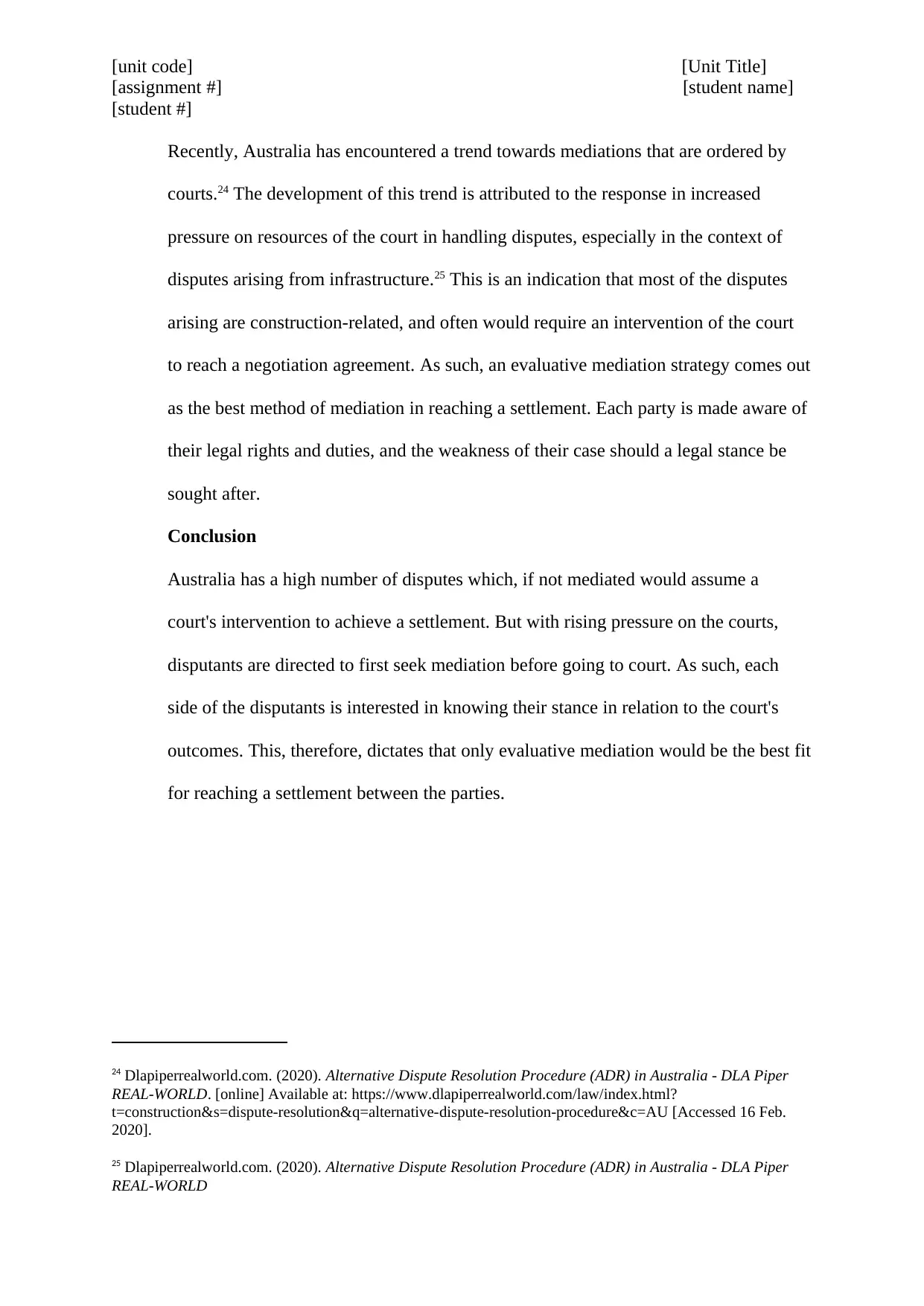
[unit code] [Unit Title]
[assignment #] [student name]
[student #]
Recently, Australia has encountered a trend towards mediations that are ordered by
courts.24 The development of this trend is attributed to the response in increased
pressure on resources of the court in handling disputes, especially in the context of
disputes arising from infrastructure.25 This is an indication that most of the disputes
arising are construction-related, and often would require an intervention of the court
to reach a negotiation agreement. As such, an evaluative mediation strategy comes out
as the best method of mediation in reaching a settlement. Each party is made aware of
their legal rights and duties, and the weakness of their case should a legal stance be
sought after.
Conclusion
Australia has a high number of disputes which, if not mediated would assume a
court's intervention to achieve a settlement. But with rising pressure on the courts,
disputants are directed to first seek mediation before going to court. As such, each
side of the disputants is interested in knowing their stance in relation to the court's
outcomes. This, therefore, dictates that only evaluative mediation would be the best fit
for reaching a settlement between the parties.
24 Dlapiperrealworld.com. (2020). Alternative Dispute Resolution Procedure (ADR) in Australia - DLA Piper
REAL-WORLD. [online] Available at: https://www.dlapiperrealworld.com/law/index.html?
t=construction&s=dispute-resolution&q=alternative-dispute-resolution-procedure&c=AU [Accessed 16 Feb.
2020].
25 Dlapiperrealworld.com. (2020). Alternative Dispute Resolution Procedure (ADR) in Australia - DLA Piper
REAL-WORLD
[assignment #] [student name]
[student #]
Recently, Australia has encountered a trend towards mediations that are ordered by
courts.24 The development of this trend is attributed to the response in increased
pressure on resources of the court in handling disputes, especially in the context of
disputes arising from infrastructure.25 This is an indication that most of the disputes
arising are construction-related, and often would require an intervention of the court
to reach a negotiation agreement. As such, an evaluative mediation strategy comes out
as the best method of mediation in reaching a settlement. Each party is made aware of
their legal rights and duties, and the weakness of their case should a legal stance be
sought after.
Conclusion
Australia has a high number of disputes which, if not mediated would assume a
court's intervention to achieve a settlement. But with rising pressure on the courts,
disputants are directed to first seek mediation before going to court. As such, each
side of the disputants is interested in knowing their stance in relation to the court's
outcomes. This, therefore, dictates that only evaluative mediation would be the best fit
for reaching a settlement between the parties.
24 Dlapiperrealworld.com. (2020). Alternative Dispute Resolution Procedure (ADR) in Australia - DLA Piper
REAL-WORLD. [online] Available at: https://www.dlapiperrealworld.com/law/index.html?
t=construction&s=dispute-resolution&q=alternative-dispute-resolution-procedure&c=AU [Accessed 16 Feb.
2020].
25 Dlapiperrealworld.com. (2020). Alternative Dispute Resolution Procedure (ADR) in Australia - DLA Piper
REAL-WORLD
⊘ This is a preview!⊘
Do you want full access?
Subscribe today to unlock all pages.

Trusted by 1+ million students worldwide
1 out of 15
Your All-in-One AI-Powered Toolkit for Academic Success.
+13062052269
info@desklib.com
Available 24*7 on WhatsApp / Email
![[object Object]](/_next/static/media/star-bottom.7253800d.svg)
Unlock your academic potential
Copyright © 2020–2025 A2Z Services. All Rights Reserved. Developed and managed by ZUCOL.